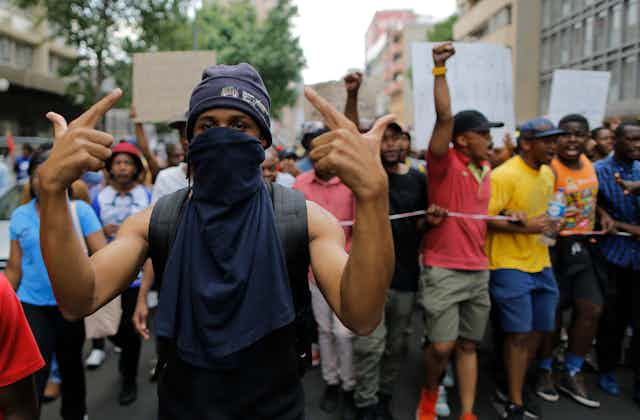A few days into the protests that swept South Africa’s campuses during October, university managers turned to the courts for help. A number of institutions obtained interdicts in an attempt to control and restrain the protests.
The interdicts were interpreted by some as an attempt by university management to stifle legitimate protest. Institutions were also mocked for interdicting the Twitter hashtags under which the student movements had organised, such as #FeesMustFall and #TUKSUPrising. Even the courts were criticised for appearing to “side” with the universities.
So what is an interdict, and why did universities turn to this extraordinary legal procedure? And, crucially, is this a worthwhile measure given how frequently interdicts are ignored?
The interdict process
Applicants most often get an interdict by going to court on an urgent basis. It is an order designed to restrain the defendants, in this case students, from continuing with wrongful activities – that is, illegal and delictual wrongs, which result in loss caused by negligence.
By its very nature, an urgent interdict subverts the principle that both parties should have a full opportunity to present their case before an order is issued. There’s an obvious tension here with the purpose of an interdict, which tries to prevent applicants from suffering irreparable damage caused by defendants’ wrongful activities.
The interdict gives applicants a tactical advantage. A full trial after an interdict has been granted is very rare and the applicant’s assertions of “interference with business” or “extreme violence” become prima facie evidence which the defendants must disprove.
A tough order to enforce
Essentially, an interdict is about respect for an order made by the constitutionally designated arbiters of conduct – the courts. It is irreparably tied to the authority of the courts and, if it is ignored, an individual or organisation can be held in contempt of court.
But there are three major difficulties in establishing contempt.
The first is the test that has been set by the courts. Contempt is the wilful and malicious refusal or failure to comply with an order of court. As the courts have put it: a deliberate disregard is not enough, since the non-complier may genuinely, albeit mistakenly, believe themselves to be entitled to act in the way that’s considered contemptuous.
The second is that courts insist the conduct which is being interdicted must be narrowly defined. This is so that defendants don’t fall into contempt for an overly broad prohibition. Those drafting the interdict must be specific about what they want the court to order.
Finally, a practical consideration. Once an interdict has been served, there must be proof beyond reasonable doubt that an organisation committed a breach of it. That is distinct from a breach by the individual members of an organisation. The liability for contempt of a court order is therefore strictly determined by reference to what the court ordered specific parties to do and the presentation of evidence that they did not do so.
Interdicts in the university context
Online photographs and videos leave little doubt that in many instances student behaviour went far beyond peaceful protest. Criminal activity – arson, assault, intimidation, destruction of property – was routine.
Some campus security guards stayed away from work to show support for the protesters, who were also calling for an end to outsourced guarding, cleaning and similar services. Their absence left staff, students and buildings without protection. What is the responsibility of university managers in this context?
There can be few who disagree that university managers have a legal and fiduciary duty to protect the people and property at an institution. Universities’ own statutes routinely require the executive and university councils to do so. When unable to offer this protection, universities have a duty to seek help where they can: from the courts and the police, both constitutionally mandated to offer this protection.
The courts can offer their authority to restrain crime, the police to prevent and prosecute crime. It would be surprising to find any critic of interdicts, if they were in the position of a vice-chancellor, doing nothing in the face of serious threats to life and property.
Facing irreparable harm
That said, one can ask whether using an interdict is desirable if it is routinely ignored, hard to draft and difficult to enforce. As I’ve said, interdicts against hashtags were a feature of several university court actions. This shows how complex it has become to restrain the way students communicate and organise.
By interdicting a hashtag the intention goes beyond restraining behaviour to restraining freedom of speech. Professor Jane Duncan has pointed out that this is overly broad. She said that:
A student calling for an entirely peaceful occupation, for example, would be prevented from doing so and using the hashtag to make their tweet searchable.
Still, the phrase “irreparable damage” – used so often to justify an interdict – is entirely appropriate where exams may be cancelled or a campus closed. There reaches a point where an interdict, if nothing else, signifies that a university, by resorting to the courts, is committing itself to legal process and the rule of law to avoid that irreparable harm.

